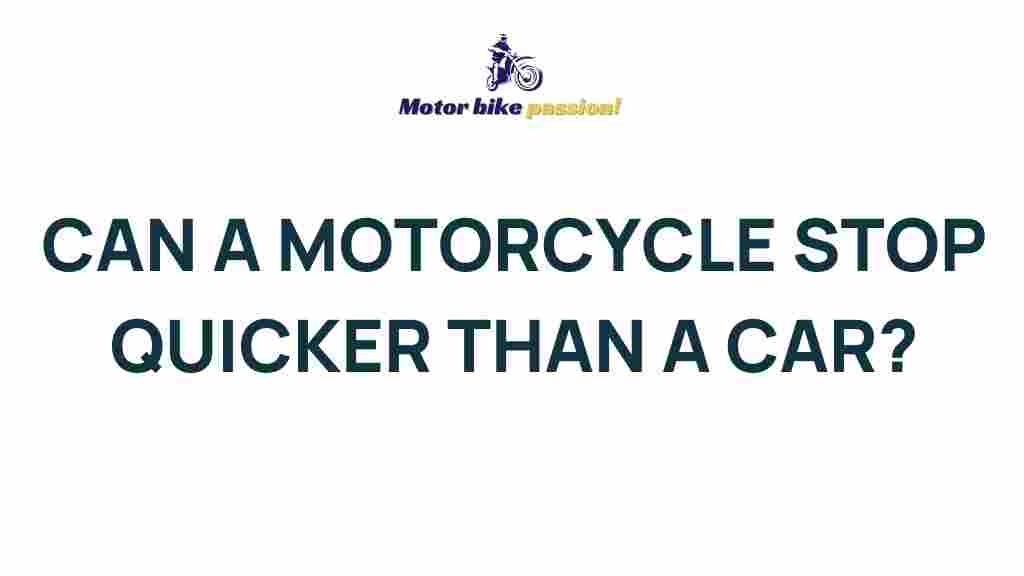Unveiling the Truth: Can Motorcycles Stop Quicker Than Cars?
When it comes to road safety, understanding the stopping distances of different vehicles is crucial. The debate between motorcycles and cars often centers around their performance, safety, and maneuverability. One of the most critical aspects of vehicle performance is how quickly they can come to a stop. In this article, we delve into the factors affecting stopping distance, compare the stopping capabilities of motorcycles and cars, and explore the implications for safety on the road.
The Importance of Stopping Distance
Stopping distance is defined as the total distance a vehicle travels from the moment the driver perceives a need to stop until the vehicle comes to a complete halt. It comprises two main components:
- Perception Distance: The distance covered during the driver’s reaction time.
- Braking Distance: The distance traveled while the vehicle brakes are applied.
Several factors influence these components, including vehicle speed, road conditions, and the driver’s reaction time. Understanding these elements helps in comparing the stopping distances of motorcycles and cars.
Factors Influencing Stopping Distance
Both motorcycles and cars have unique characteristics that affect their stopping distances:
- Weight: Heavier vehicles generally require more distance to stop.
- Tire Grip: The type of tires and their condition can significantly impact braking performance.
- Braking System: Advanced braking systems, like ABS, can enhance stopping power.
- Speed: Higher speeds increase both perception and braking distances.
- Road Conditions: Wet, icy, or uneven surfaces can drastically reduce a vehicle’s ability to stop quickly.
Motorcycles vs. Cars: A Stopping Distance Comparison
To understand whether motorcycles can stop quicker than cars, we must look at empirical data and studies. Generally, motorcycles can achieve shorter stopping distances under certain conditions due to their lighter weight and braking capabilities.
Stopping Distance of Motorcycles
Research shows that the average stopping distance for a motorcycle traveling at 60 mph can range from 120 to 140 feet, depending on various factors such as rider skill, the motorcycle type, and road conditions. Here are some key points about motorcycle braking:
- Motorcycles can utilize both front and rear brakes effectively to reduce stopping distances.
- Rider experience plays a significant role; skilled riders can achieve shorter stopping distances.
- Advanced braking systems, such as ABS, improve the safety and effectiveness of braking.
Stopping Distance of Cars
In contrast, cars tend to have longer stopping distances. For a car traveling at the same speed of 60 mph, the average stopping distance can range from 150 to 180 feet. Factors that affect car braking include:
- Cars are usually heavier, which means more force is needed to bring them to a stop.
- Most cars have a larger footprint, which can affect their maneuverability in emergency stops.
- ABS technology is also common in modern cars, which helps to maintain traction during braking.
Practical Implications for Safety
The practical implications of stopping distance are significant for road safety. Here’s how the differences between motorcycles and cars affect safety:
- Visibility: Motorcycles are smaller and may be less visible to other drivers, which can lead to longer perception distances.
- Rider Awareness: Motorcyclists often have to be more aware of their surroundings to react quickly to obstacles.
- Braking Techniques: Riders must be trained in effective braking techniques to maximize safety.
Step-by-Step: How to Measure Stopping Distance
To understand stopping distances better, it can be helpful to measure them practically. Here’s a simple step-by-step process:
- Find a Safe Location: Choose a flat, dry area away from traffic.
- Use Markers: Place cones or markers at the starting point and the stopping point.
- Drive at a Consistent Speed: Accelerate to a predetermined speed (e.g., 30 mph, 40 mph, 60 mph).
- Apply Brakes: At a specific marker, apply brakes fully and measure the distance to the stopping point.
- Record Conditions: Note the road conditions, tire conditions, and vehicle type.
This simple experiment can give you a more practical understanding of how different vehicles behave under braking.
Troubleshooting Tips for Safe Braking
For both riders and drivers, safety is paramount. Here are some troubleshooting tips to enhance braking performance and safety:
- Regular Maintenance: Ensure that your vehicle’s brakes, tires, and suspension systems are in good condition.
- Practice Emergency Stops: Familiarize yourself with your vehicle’s braking response in a safe environment.
- Stay Aware: Always be alert to your surroundings and anticipate the need to stop.
- Training Courses: Consider taking advanced riding or driving courses to improve your skills.
Conclusion
In conclusion, the question of whether motorcycles can stop quicker than cars largely depends on various factors, including vehicle type, rider or driver skill, and environmental conditions. While motorcycles generally have shorter stopping distances due to their lighter weight and agile handling, the effectiveness of braking can vary widely based on the circumstances.
Understanding stopping distances and practicing safe braking techniques are essential for both motorcycles and cars. By enhancing our knowledge and skills, we can contribute to safer roads for everyone.
For more information on vehicle safety and performance, you can visit this external resource. Additionally, for more articles related to road safety, check out our site here.
This article is in the category Safe Driving and created by MotorBikePassion Team

1 thought on “Unveiling the Truth: Can Motorcycles Stop Quicker Than Cars?”